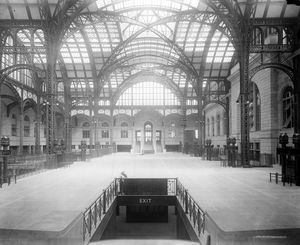When transit centers were beautiful
Oct. 28, 1963 was the first of Penn Station's last days.
For those who appreciate architecture, and prefer your civic buildings to inspire awe, this was a depressing turn of events. Much like leaders in every other American city after World War II, New York City's civic thinkers thought the days of mass transit via rail were done, so there was very little effort to save what is now regarded as "one of the crown jewels of New York’s civic and architectural heritage," according to Michael Beschloss, writing in the New York Times.
In his article, "Penn Station: A Place That Once Made Travelers Feel Important," Beschloss describes the importance of the station not just in New York's history, but in the larger sense of how buildings should make us feel.
The august and spacious building was designed by the architectural firm McKim Mead & White, which had also reconfigured the White House for Theodore Roosevelt to make it more suitable for the leader of a world colossus. The terminal’s brash, white, eagle-crowned exterior with 84 granite Doric columns was based on the Acropolis, the Brandenburg Gate, St. Peter’s Basilica and the Bank of England. Its vast, lofty waiting hall was derived from the ancient Roman baths of Caracalla, Diocletian and Titus.
Charles McKim, the co-founder of the famous architectural firm, pronounced his Pennsylvania Station “a monumental gateway and entrance” to New York City. He enjoyed thinking of the “well-gowned women who would sweep up and down his broad staircases,” one of his friends said.
Or, as the art historian Hilary Ballon wrote in 2002: “Penn Station did not make you feel comfortable; it made you feel important.”
The photo above shows Penn Station's main concourse. Can you imagine waiting for a bus or train there?
As the Spokane Transit Authority begins to remodel downtown Spokane's transit plaza, and asks voters to fund a new transit center on the West Plains, what do you think they should consider? Bigger and grander? Or are the days of "august and spacious" transit stations over? Should we build a pragmatic, no-nonsense structure?

